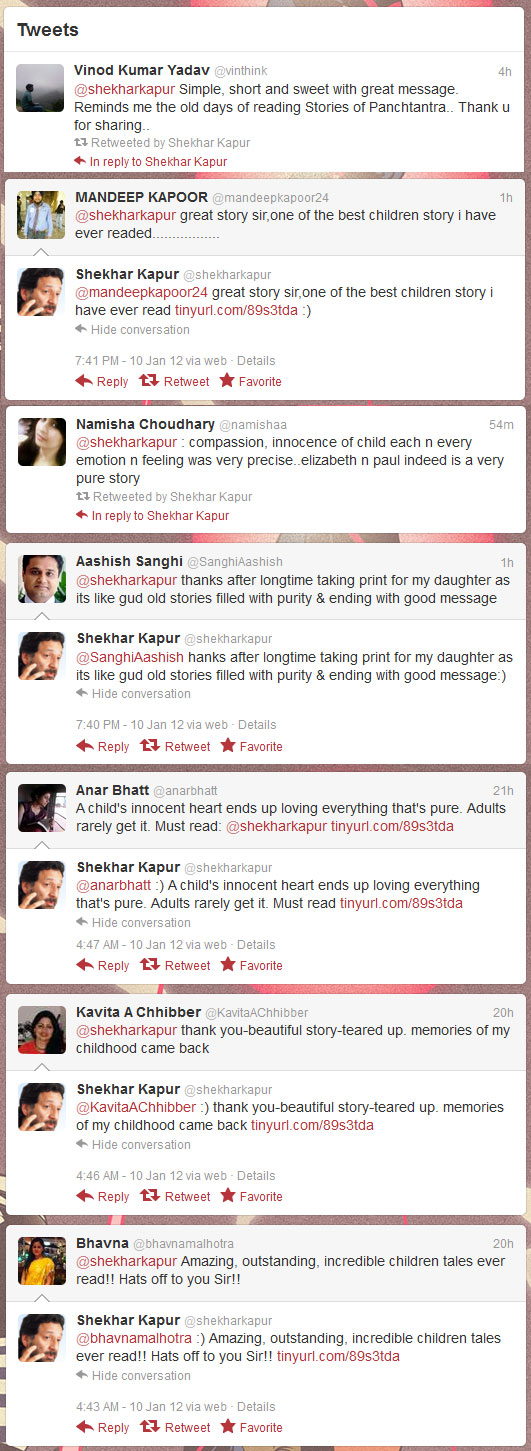Shekhar Kapur is up to something really interesting, on Twitter!
Observe the following threads that I gleaned from his public stream. The greyed ones are visible only when you click on his (Kapur’s) tweet and when the conversation thread opens up. For all practical reasons, you see only Kapur’s tweets, as anybody else’s public stream on Twitter.
Let me not repeat in detail what I wrote about earlier (using Chetan Bhagat’s example – The incestuous nature of self-praise on Twitter Retweets) on celebrities retweeting praise from completely non-entities (like you and me – normal folks, I mean).
If you were to think deeply about it, it perhaps doesn’t add up – here’s Shekhar Kapur, celebrated film maker, with more than a lakh followers. And he retweets to his 1 lakh+ followers the opinion of a Vinod Kumar Yadav (with 26 followers). Do his followers care what Vinod Kumar Yadav thinks about Kapur’s Elizabeth and Paul pigeon story? Or, in other words, does Vinod Kumar Yadav’s positive opinion about Kapur’s pigeon story enthuse his other followers to read the story? I’d assume another celebrity saying something positive would have some effect, if that celeb tweet is retweeted by Kapur, but I still don’t see the logic in retweeting random non-entities.
Note: I’m not against random non-entities on Twitter. I’m one too. My worry is more about Shekhar Kapur’s credibility that he has to showcase random, unknown tweeters’ praise for his story.
The other tweets showcase something even more interesting.
Notice the conversation with Mandeep Kapoor (direct link – or, just see the screenshot above, for reference). You will not see Mandeep’s tweet by default – so, all you see is Kapur’s tweet, where, it seems like he is telling Mandeep (since Mandeep’s Twitter handle is in the beginning),
great story sir,one of the best children story i have ever read tunyurl.com/89s3tda 🙂
This, interestingly, is not Shekhar Kapur’s tweet. This is Mandeep Kapoor’s tweet. Shekhar’s addition is in 3 forms –
1. he edits Mandeep’s overenthusiastic typo ‘readed’ into ‘read’
2. he adds the URL of his Elizabeth and Paul pigeon story (which Mandeep was responding to and DID NOT have the URL in his tweet)
3. adds a smiley in the end.
This is quite a fascinating use of Twitter. It seems, to a normal visitor of Shekhar Kapur’s public stream (and also stumbling on his tweets through a client like TweetDeck, for instance) that,
1. Shekhar Kapur tells other people (in this case, Mandeep Kapoor) that he (Kapur) thinks his own story is ‘great’
2. he addresses Mandeep Kapoor as ‘sir’
3. he tells Mandeep that his own (Kapur’s) story is one of the best children (sic) story he himself has read.
This is not an isolated tweet. Take a look at the next conversation between Kapur and Aashish Sanghi (direct link to the conversation – or just see the screenshot above).
You won’t see Aashish’s tweet by default, but when you do, it looks bizarre that Kapur tells (when you see Kapur’s tweet) Aashish what he said, verbatim.
Aashish says,
“@shekharkapur thanks after longtime taking print for my daughter as its like gud old stories filled with purity & ending with good message”
Kapur responds, as-is,
“@SanghiAashish hanks after longtime taking print for my daughter as its like gud old stories filled with purity & ending with good message:)”
It is a response, not a quote or a retweet – if you notice. Kapur basically paraphrases a tweeter’s tweet as-is, as a response, by missing the T of thanks and adding a smiley in the end.
What others usually do in this situation is to respond with just a smiley. This is quite understandable since Aashish will see that as a response to his praise for Kapur’s story. And this smiley will be visible (ideally – read bullet points 2 and 3 under ‘Things to note’ in Twitter’s help pages on @replies and @mentions) to only those people who are common followers of Kapur and Aashish.
But now, all of Shekhar Kapur’s followers will get to see Kapoor thanking someone named Aashish Sanghi and informing him (and the rest of the world) about his intention to take a printout for his daughter (Kaveri, Kapur’s daughter; not Aashish’s daughter – notice who is saying what; it is confusing, I agree!).
These are not just 2 random instances. Take a look at Anar Bhatt’s tweet (which is hidden, by default) and then see Kapur’s tweet. Or Kavita A Chhibber’s tweet and Kapur’s response. Or even Bhavna Malhotra’s tweet and Kapoor’s response.
You get the drift? Interesting, isn’t it?

